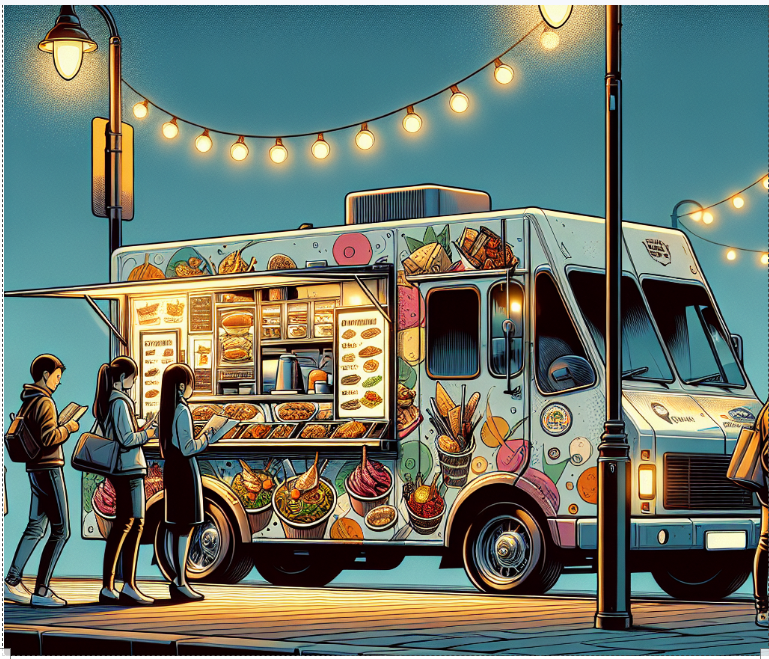Calculate your food truck startup cost for 2024 with our detailed guide. Get insights on expenses and budgeting strategies.
Top Tips for Food Truck Start Up Cost in 2024
Key Highlights
- Starting a food truck business is generally less expensive than a traditional restaurant but requires significant investment.
- Expect to spend $50,000-$175,000 for a new food truck, while used options range from $30,000 to $100,000.
- Essential equipment, permits, licenses, and initial inventory contribute to upfront costs.
- Operational expenses include fuel, maintenance, insurance, staffing, food supplies, and marketing.
- Consider factors like location, menu complexity, and local regulations when budgeting for your food truck venture.
Introduction
The idea of owning a food truck and dishing out tasty treats wherever you go is pretty tempting. But, before you start driving around, it’s super important to have a solid business plan that lays out how much money you’ll need to get started. This means getting a clear picture of the cash required not just at the beginning but also for keeping your food truck running day after day. Let’s dive into what costs you should keep in mind as you set up your own food truck business.
Understanding the Basics of Food Truck Startup Costs
Starting a food truck business means getting to know the money side of things first. It’s less expensive than opening a regular restaurant, but you still need to be ready to spend quite a bit. The cost can change depending on where you are, what kind of food you want to sell, and your personal choices.
With starting up comes the big part of buying the food truck itself; it eats up most of your startup budget. On top of that, there’s important stuff like kitchen gear for cooking, keeping things cool with refrigeration units and systems for making sales at checkout points. And let’s not overlook permits and licenses plus all the initial supplies including ingredients needed – these add more numbers onto your early costs.
The Initial Investment: Buying or Building Your Food Truck
When thinking about getting a food truck, you’ve got a few paths to choose from, and each one affects how much money you’ll need. Going for a new food truck means it’s reliable and can be made just the way you want, but it’s also pricier—expect to spend somewhere between $50,000 and $175,000.
On the other hand, picking out a used food truck could cut down your starting costs quite a bit since they usually go for between $30,000 and $100,000. But remember to consider extra expenses like fixing or updating things so that the used truck fits what you’re looking for and is safe to use.
Cost Breakdown-
A food truck business requires a few different things before it can begin. As an illustration, we require a food truck, a license, permits, inventory, truck fuel, ongoing maintenance expenses, insurance, and other fees. Which state you wish to start your business in will determine the cost of licenses and permits. However, you must have at least $30,000 set aside for licenses, permits, and a year of legal compliance. Purchasing a used truck will help you save money. Let’s investigate how much licenses and permits cost in various states.
Licenses and permits cost
First, you need to collect some documents for applying to food truck licences and permits. Those are-
- Annual Business License Application
- Social Security Number (SSN)
- An EIN Number
- Food Truck Permit Application
- Liability insurance- $1600 to $4500 per year
- To choose what classification of business you’ll be? Individual or partnership business
- A business brand name
- An address and phone number
- DHEC permit
- Public Health Permit- usually $150 to over $1000
- Food Seller’s Permit- not more than $15 per employee
- Driver’s license
- Detail guideline about Food Truck Business Plan
- Employee Health Permit
You will get food truck application form, every state Department of Health and Environmental Control Website.

Your overall licenses and permits cost should not exceed over $30,000. But that depends which state and which county you are applying for. California, Boston more expensive in comparing to Indianapolis, Denver and Portland.
Vehicle Registration and Parking Fee
In addition, you have to count some other costs like vehicle registration, parking and fire safety permit. Let’s explore those variable costs.
Vehicle Registration– fee $100 to $200 per year
Parking Fee– $200 to $2000 per month. Yoy can minimize this cost by selling in front of your relative’s stores. You can save this huge amount of money every month. Or you can sell your items in different organizations or offices. Thats’s how you do not need to pay for parking fee every day.
Fire Safety Permit– fee $100 to $200 per year.
Essential Equipment and Supplies for Day-to-Day Operations
To make sure your food truck runs smoothly, it’s crucial to have the right gear for preparing and serving food. This means getting cooking tools like ovens, grills, fryers, and stoves that match what you plan to cook.
You can use different kind of stoves for food truck. Here is some of them, let’s check it out-
Techwood 1800W Dual Electric Stoves
Camp Chef Ranger II Tabletop Stove
On top of machines for cooking, remember to get a fridge for keeping ingredients fresh, freezers if necessary, and plenty of counter space where you can prepare meals. Safety stuff is also important—make sure you have fire extinguishers, first aid kits,and good airflow systems in place to meet health rules.
According to my research, many people like to buy VEVOR Commercial Refrigerator, 72″ Sandwich & Salad Prep Table. This refrigerator has ample space for storing foods. Also, it has a a detachable chopping board of 70.9 x 15.5 in. So, you can get ample space for preparing foods. I also put a list of few refrigerators those are best for food truck. You can choose which one is best for you. Let’s figure it out-
Buy Refrigerator from Amazon
48″ Worktop Undercounter Refrigerator
29″ Sandwich & Salad Prep Table Commercial Refrigerator
BODEGACOOLER Commercial Merchandiser Refrigerator
12V Car Refrigerator Portable Fridge Freezer
Also think about smaller things that are super important too: utensils for serving, equipment to keep food stored safely, cleaning materials, and throwaway items for eating off.
Breaking Down the Costs: What You Need to Know
Starting a food truck does require a big chunk of money upfront, but it’s just as crucial to remember the ongoing costs that will keep your wheels turning. With expenses like gas for the truck, buying ingredients for your dishes and drinks, paying your team, covering insurance fees, keeping up with vehicle repairs, and getting the word out there about your business through marketing – all these need careful consideration. By looking closely at these expected costs you can figure out how much to charge for your menu items so that making a profit becomes achievable.
New vs. Used Food Trucks: A Cost Comparison
When you’re deciding to get a food truck, how much money you want to spend plays a big role. If you go for a new truck, which can cost anywhere from $75,000 to $150,000, it’s comforting to know that it comes with warranties and won’t need fixing right away. But remember, getting back the money spent on this might take some time.
On the other hand, choosing a used food truck could be easier on your wallet since they range from $40,000 to $80,000. Just make sure you check its condition carefully because even though it’s cheaper at first glance; repair or upgrade costs could add up later.
In the end of things like budgeting and risk-taking into account as well as how much customization is needed before making your choice. A used truck that’s been kept in good shape can save lots of cash upfront while buying new means starting fresh but also dealing with higher initial costs.
Kitchen Equipment and Technology: Investments for Efficiency
For a new food truck, it’s crucial to put your money into the best kitchen gadgets and tech. This means getting top-notch cooking gear and a smooth-running POS system. With these investments, you make everything run more smoothly – from whipping up meals to handling orders, which makes customers happy and helps sell more. Also, using the latest kitchen tech can cut down on how much you spend fixing stuff over time. To stay ahead in the busy world of food trucks, bringing in cutting-edge tools and equipment is key for doing things better and making more profit.
Read more- Starbucks Success Story, Franchise Cost and Global Expansion Strategy
Operating Expenses of Running a Food Truck in 2024
Starting a food truck in 2024 means you’ll have to deal with some ongoing costs that are crucial for keeping your business up and running. These operational costs play a big role in how much money you can make.
By getting a good handle on these expenses, you ensure your food truck stays financially healthy. Keeping an eye on what’s going out helps you make smart choices about setting prices, managing stock, and handling the day-to-day of your business.
Fuel, Maintenance, and Insurance: Keeping Your Truck on the Road
To make sure your truck runs smoothly and avoids sudden problems, it’s crucial to keep up with regular upkeep. This includes getting oil changes, rotating the tires, and tuning up the engine. These maintenance costs help your vehicle last longer.
Having insurance is a must to protect what you’ve put into your truck. Getting comprehensive coverage means you’re protected against accidents, theft, or any damage that might happen.
With fuel prices always changing, this can be a big part of what you spend on your truck based on how much you drive. By choosing the best routes, thinking about how much gas your truck uses, and keeping an eye on fuel prices can help control these costs.
Staffing and Labor Costs: Balancing Quality and Budget
When running a food truck, picking the right number of staff members is super important. You’ve got to think about how complicated your menu is, how you serve your customers, and when you’re busiest.
With labor costs – that’s stuff like paychecks and maybe some benefits for your team – it can really eat into what you spend on other things. It’s smart to know what the rules are about minimum wage where you live so everyone gets paid fairly.
By being flexible with when people work and teaching them different jobs within the truck, you can keep costs down without making service worse for your customers. Good management not only makes sure employees are happy but also helps make sure your food truck does well.
Legal and Administrative Costs
To run your food truck the right way, it’s important to understand and follow all the legal and admin rules. Sometimes people forget about these costs, but they’re really important for making sure everything goes smoothly.
Getting help from a professional can make things easier when you need to apply for permits, renew licenses, or make sure you’re meeting health and safety standards. By keeping up with all the laws and paperwork needed for your food truck, you can avoid any trouble or fines that might come up.
Navigating Permits, Licenses, and Regulations
Running a food truck means you have to follow some rules, like getting the right permits and licenses. First off, you need a business license so you can run your show legally in your area.
With a food truck permit that’s all about mobile food selling, they’ll check out your truck, how you handle equipment and prepare food. This is to make sure everything’s clean and safe for everyone.
On top of that, look into where it’s okay to park and set up shop because local laws have a say in this. Keeping up with these rules helps avoid any trouble or extra costs down the line.
Commissary and Parking Fees: Understanding the Necessities
In lots of places, if you run a food truck, it’s required by law to use what’s called a commissary kitchen. This is where you can safely get your food ready and keep it stored. These kitchens are equipped with everything needed for cleaning up, preparing meals, and sometimes even storing stuff while making sure everything meets the health department’s rules.
When thinking about costs that keep coming up as part of running your business, don’t forget about the money you’ll need to spend on renting space in a commissary kitchen. How much this will set you back depends on where the kitchen is located and what kind of features it offers. Generally speaking, these fees give you access to workspaces in the kitchen along with places to store things and take care of trash.
On top of that, finding a safe place with permission for parking your food truck when it’s not being used is super important. You should look into different parking options carefully—think about how secure each spot is whether getting there is easy or hard; also consider how much paying for an official parking spot might cost.
Read more- Chick Fil A Success and Growth Strategies
Marketing and Brand Development
To draw customers to your food truck, it’s crucial to have a solid brand identity and smart marketing tactics. Putting effort into making your brand look good visually is a great place to start. With social media, you can gather a group of loyal followers, chat with folks who might want to try your food, and share what’s on the menu along with where you’ll be parked. Don’t forget about the power of people talking; getting your customers to leave reviews and suggest your truck to others still works wonders.
Digital Marketing Strategies for Food Truck Owners
In the world of food truck marketing today, it’s super important to make good use of online spaces. With social media platforms like Instagram and Facebook, you can really show off what makes your menu items special by posting great photos and videos.
By chatting with people who follow you, answering their comments and messages quickly, you create a friendly vibe around your food truck. It’s cool to share what goes on behind the scenes, celebrate stories from your customers, and let everyone know where you’ll be next or if there are any fun events coming up.
You might also think about using targeted ads on social media to get in touch with more folks who’d love your food. By focusing these ads on areas close by, you’re more likely to find potential customers right in your neighborhood.
Branding and Customer Experience: Making Your Truck Stand Out
Make sure your truck catches people’s eye by putting money into special branding that clicks with the folks you want to reach. With social media, get everyone talking about your food truck and pull in those who might want to try it out. Add a POS system for easy payments, making things better for your customers. Think about getting safety gear and having a look that draws people in. Aim to give them something they’ll remember through what your food truck is all about and what you serve up. Keeping customers happy should be top of mind if you want to stand out from the crowd in the busy world of food trucks.
Financial Planning and Management for Food Truck Entrepreneurs
For anyone starting a food truck, having a solid plan for your finances is super important. This means you need to know all about the money you’ll spend to get started, what it will cost to keep things running, and how much cash you expect to make.
You should put together a detailed business plan that covers what financial targets you’re aiming for, how you plan on telling people about your food truck, and the way everything will operate day-to-day. Don’t forget to check in on your plan regularly and tweak it as needed based on how well things are going or changes in the food truck world.
Setting Up for Success: Budgeting and Forecasting
To kick off a successful food truck business, getting your money matters straight is key. Start with putting together a detailed startup budget that covers everything from buying the truck and equipment to getting permits and stocking up on initial supplies.
Once you’re up and running, keep a close eye on what’s coming in and going out by tracking your expenses and income carefully. This helps you stay on top of how much cash you have, manage your stock well, and make smart choices about where your money goes.
With changes in sales patterns, seasons rolling in and out, or shifts in the market landscape always update how you think the future will look financially for your food truck. Being spot-on with these predictions means you can get ready for tough times ahead of time while also jumping at chances to grow when they come around.
Managing Cash Flow and Expenses: Tips for New Owners
Handling your money well is super important, especially when you’re just starting out with your food truck. By using your POS system, you can keep an eye on how much you’re selling, figure out which menu items are a hit, and check on what’s in stock without missing a beat.
To make sure the cash keeps flowing smoothly, try to work out better deals with the folks who supply your ingredients. Look into getting some short-term loans if needed and always have some extra cash tucked away for emergencies that pop up.
It’s also smart to go back and look at your business plan now and then. Compare it with how things are actually going. This way, by looking over the numbers closely, you can spot where there might be room to do things better or ways to bring in more profit from those tasty dishes you serve.
Conclusion
Wrapping things up, it’s super important for anyone dreaming of starting a food truck business to really get the full picture of what it’ll cost. This means looking at everything from buying your truck at the start, covering day-to-day running costs, and figuring out how to promote your business. Each part is crucial for making sure you do well. By carefully planning out your money matters and making smart choices along the way, you can overcome any hurdles and make your food truck profitable.
Always remember that being wise with money and making thoughtful decisions are essential if you want to keep growing your food truck venture in 2024. Wishing you all the best as you set off on this exciting business adventure!
Frequently Asked Questions
How Much Should I Budget for Initial Food Truck Startup Costs?
Starting a food truck isn’t cheap, with costs usually falling between $50,000 and $150,000 or sometimes even more. This price tag covers everything you need to get going: the vehicle itself, all the gear inside it, any permits and licenses required by law, plus your initial stock of ingredients. To really grasp what you’re in for financially from day one; putting together a comprehensive startup budget is key.
What Are the Most Common Financial Mistakes New Food Truck Owners Make?
Many new food truck owners don’t fully consider all the costs involved, like what they’ll spend on ingredients, gas, and keeping their trucks in good shape. On top of that, not managing their money well or changing up what’s on the menu to make more profit can trip them up. They also sometimes forget to follow rules about how workers should be treated.
How long does it usually take for a food truck business to become profitable?
It typically takes around 1 to 2 years for a food truck business to become profitable. Factors such as location, menu pricing, marketing strategies, and operational efficiency play significant roles in determining the exact timeline for achieving profitability in the food truck industry.









